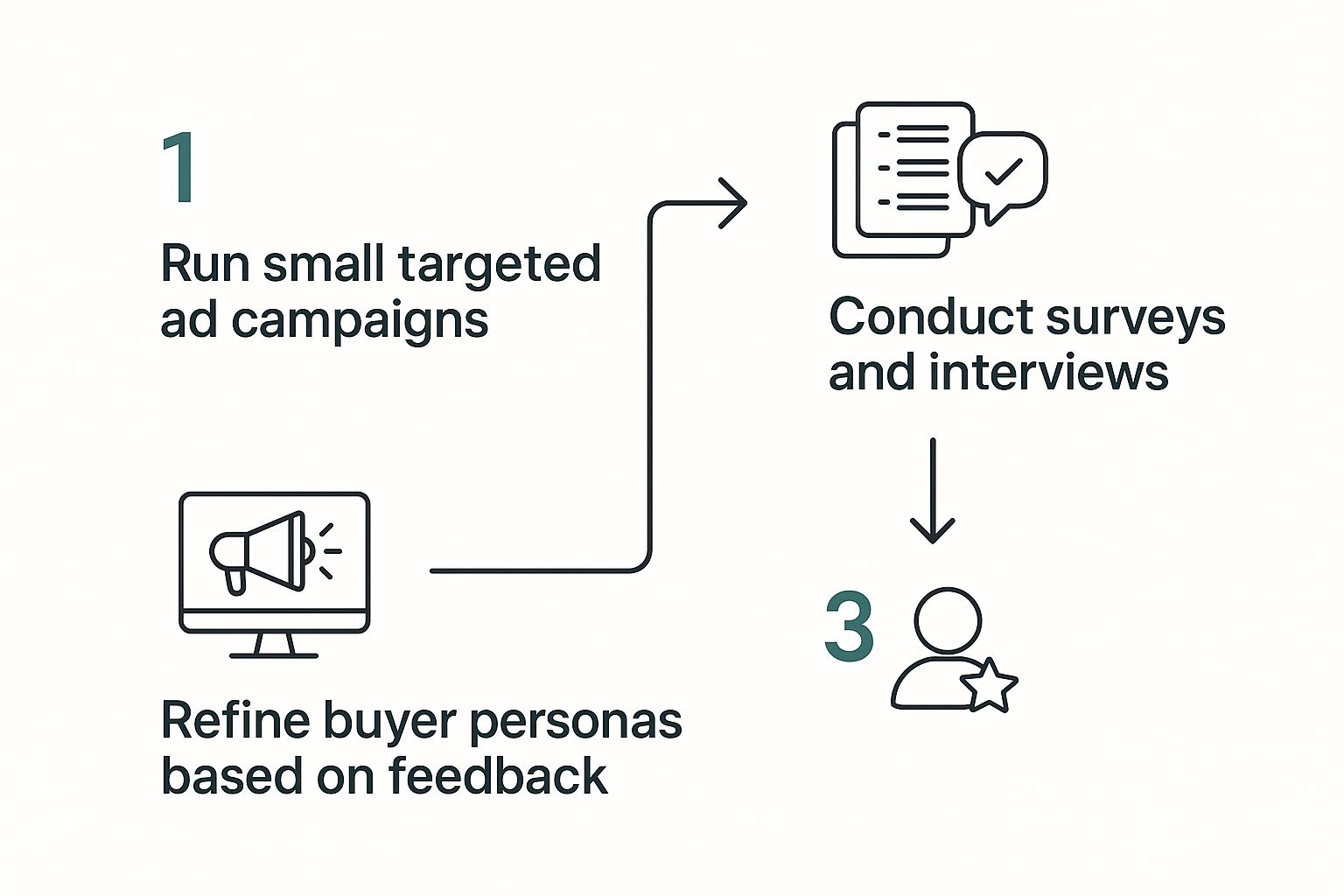To find your target audience, you need to dig into your existing customer data, see what your competitors are up to, and then stitch all that information together into detailed buyer personas. It’s a three-part process that swaps guesswork for a data-backed strategy, making sure your marketing efforts actually connect with the people most likely to buy.
Why Precision Targeting Beats Generic Marketing

Imagine shouting into a crowded stadium, hoping your perfect customer just happens to be listening. That’s generic marketing. It’s expensive, it’s lazy, and it’s a great way to burn through your budget.
Now, picture walking right up to that person, knowing their name, understanding their biggest headaches, and handing them the perfect solution. That’s the power of knowing exactly who you’re talking to.
When you have a crystal-clear picture of your audience, every blog post, every ad, and every product feature becomes sharper and more effective. You stop trying to write for everyone—which usually means you connect with no one—and start crafting messages that hit home with a specific group of people.
The Real Cost of a Scattergun Approach
Going broad isn't just inefficient; it's a massive waste of money. A campaign targeting "small business owners" might reach a million people. But what if only 10,000 of them are actually in the market for your B2B software? You just paid to reach 990,000 people who couldn't care less.
This is why nailing down your target audience isn’t just a "nice to have." It's the foundation that everything else is built on.
A well-defined target audience is the difference between a marketing strategy and a marketing wish. It turns random shots in the dark into a calculated, high-ROI plan.
From Vague Ideas to Actionable Insights
So, how do you get from a fuzzy idea of "our customer" to a profile you can actually use? The process boils down to a few core pillars. We're going way beyond basic demographics like age and location to get at the why behind your customers' decisions.
To truly understand your audience, you need to look at three key areas. This table breaks down what each pillar means and why it matters.
Core Pillars of Audience Identification
| Pillar | What It Means | Key Goal |
|---|---|---|
| Behavioral Data | Analyzing what your customers do, not just who they are. Think purchase history, website engagement, and content consumption. | To understand real-world actions and identify patterns in how people interact with your brand. |
| Psychographic Details | Uncovering their values, interests, pain points, and motivations. What keeps them up at night? What are their biggest professional goals? | To get inside their heads and learn what truly drives their purchasing decisions. |
| Competitive Landscape | Seeing who your competitors are successfully reaching and, more importantly, identifying the underserved segments they might be ignoring. | To find your unique market position and spot opportunities for growth that others have missed. |
Mastering these elements helps you build a complete picture that leads to better products, more compelling copy, and smarter ad spending. This focused approach is also critical for implementing effective lead generation best practices that attract high-quality prospects right from the start. This guide will give you the roadmap to get there.
Find Clues Within Your Existing Customer Base
Before you spend a single dollar on fancy market research, take a look at the people who have already paid you. Your current customer base is an absolute goldmine of information, giving you the most direct path to understanding who you should be targeting next.
These people are your proven market. Digging into their shared traits is the quickest way to sketch out your first customer persona. The real goal isn't just to find out who they are, but why they chose you in the first place.
Dive into Your Data Analytics
Your website and social media analytics are the perfect places to start. These tools are already collecting objective data on who’s visiting your site and engaging with your brand, no surveys required.
Jump into your Google Analytics account first. It gives you a clean snapshot of your audience’s basic demographics—age, gender, and location. This data immediately helps you bust any assumptions you might have. For instance, you might think you’re selling to young urbanites, but the numbers reveal 45% of your site traffic actually comes from people aged 45-54.
Next, check your social media insights. Platforms like Facebook and Instagram offer surprisingly deep audience analytics that show you:
- Top Locations: Which cities and countries are your followers really from?
- Age & Gender Breakdown: Who makes up the core of your engaged audience?
- Active Times: When are your followers most likely to see and interact with your posts?
This information helps confirm the patterns you see in Google Analytics and sharpens your understanding of where your message is hitting home.
Don’t just glance at the numbers—look for the story they tell. A high concentration of customers in a specific city could signal a regional trend, while a surprising age demographic might reveal an entirely new market opportunity.
Uncover Behavioral Patterns
Demographics tell you who your customers are. Behavior tells you what they actually want. By analyzing purchase history and engagement metrics, you can see what practical needs your audience has and how they truly interact with your brand.
Look inside your CRM or e-commerce platform for the real story. Start asking questions like:
- What are my most popular products or service tiers?
- What’s the average order value?
- Are customers typically one-time buyers, or do they keep coming back?
A customer who repeatedly buys your premium software subscription is worlds apart from someone who only buys an entry-level product during a flash sale. Identifying these different segments is critical.
Don't forget to check your customer support tickets and FAQs. What questions pop up over and over again? These recurring issues are direct signals of your audience's pain points and knowledge gaps, giving you perfect topics for your next blog post or email campaign.
The data you pull together here is also foundational when you decide to learn how to build an email list filled with qualified leads. By combining these different data sources, you start building a real, multidimensional view of your ideal customer, turning a vague idea into a data-backed profile.
Analyze Market Trends and Competitor Audiences

Your ideal customers don't exist in a vacuum. They’re out there right now, actively engaging with your competitors and the wider market. If you only look at your own data, you're missing the bigger picture—and probably some huge opportunities.
Competitor analysis isn't just about knowing who else sells a similar widget. It's about reverse-engineering their success. You need to dig into who they’re talking to, what they're saying, and—most importantly—who they might be ignoring. Think of it as a shortcut to understanding what already resonates with your potential audience.
Decode Your Competitors' Audience Strategy
Time to put on your detective hat. Start by visiting the websites and social media profiles of your top three competitors. The language they use is your first big clue. Is it formal and technical, or casual and full of slang? This tells you whether they're aiming for seasoned pros or total newcomers.
Next, dive into their social media. Who is actually commenting on and sharing their posts? Check out their job titles and see what other brands they follow. You'll start to get a feel for the community your competitor has managed to build.
Pay close attention to the questions people ask in the comments. These are direct insights into your audience's knowledge gaps and pain points. Each question is a potential content idea handed to you on a silver platter.
Don't stop there. Go read their customer reviews on sites like G2, Capterra, or even Google. This is a goldmine. You’ll find direct quotes about what people love, what drives them crazy, and what they wish the product could do. These unfiltered thoughts reveal the exact problems people are trying to solve.
Use Social Listening to Find Untapped Segments
While checking out your competitors shows you who is being targeted, social listening helps you find the conversations happening on the fringes. Tools like Brand24 or Sprout Social let you monitor keywords across the web, giving you ears everywhere.
Instead of just tracking your own brand, set up alerts for:
- Industry keywords: Monitor terms related to your field to see what challenges people are openly discussing.
- Competitor names: Keep an eye on what customers are saying about them, especially the complaints.
- Problem-based phrases: Listen for questions like "how do I fix X?" or "what's the best tool for Y?"
This proactive approach helps you spot underserved needs before anyone else does. You might discover a niche group using a competitor’s product in a totally unconventional way—a segment nobody is actively marketing to yet. For example, a project management tool might notice a growing number of freelance artists using their software for client work. Boom. New audience.
Tailor Your Approach to Platform Demographics
Knowing where your people hang out online is half the battle. You can't just spray your message everywhere and hope for the best.
For instance, Facebook's largest age group is 25-34-year-olds, making up 31.1% of its user base. But younger audiences? They're moving on. The 18-24 crowd now spends just 22 minutes a day there, preferring platforms like TikTok and Instagram.
You can dig into more social media demographics to make sure your message is hitting the right people on the right channel. Wasting your budget on the wrong platform is one of the easiest marketing mistakes to make.
Craft Buyer Personas That Feel Real

So, you've done the hard work of gathering customer data and digging into market trends. You're probably sitting on a goldmine of insights. But let's be honest—raw data doesn't write compelling ad copy or inspire your product team. This is where you bring that data to life by creating a buyer persona.
Think of it as building a semi-fictional character who embodies your ideal customer. A great persona is more than just a list of bullet points; it's a story. You're moving from a vague concept like "small business owner" to a real, relatable person like "Startup Sarah." This gives your entire team a clear picture of who they're working for.
Building Your Persona From The Ground Up
The real goal here is to create a profile that feels like you're reading about an actual human being. Anyone on your team, from a brand-new marketer to a seasoned developer, should be able to look at it and instantly understand who you're trying to help.
It sounds simple, but start by giving your persona a name and finding a stock photo that fits their description. This small step makes them feel instantly more tangible. Then, you can start layering in the details from your research.
A truly useful persona should include:
- Demographics: Nail down the basics like their age, job title, income, and education. This sets the stage.
- Goals & Motivations: What are they trying to accomplish in their career? What gets them out of bed in the morning?
- Challenges & Pain Points: What are the biggest headaches and obstacles they deal with every day? What frustrates them the most?
- Watering Holes: Where do they hang out online to get information? Be specific—name the blogs, podcasts, social media platforms, or influencers they follow.
This approach transforms a fuzzy idea into a practical tool that can steer decisions across your entire company.
From Vague Concepts to Actionable Insights
Let's look at a real-world example of how this works. A lazy persona might just say, "Targets B2B marketers." That's not helpful. An actionable one, however, paints a vivid picture.
Meet "Marketing Manager Mike"
- Age: 32
- Role: Marketing Manager at a mid-sized SaaS company.
- Goals: He's laser-focused on proving the ROI of his campaigns so he can finally get that promotion to Director.
- Challenges: Mike is drowning in data from a dozen different tools. He struggles to pull it all together into a cohesive report for his boss and feels like he spends more time crunching numbers than actually thinking about strategy.
- Watering Holes: He never misses an episode of the Marketing Over Coffee podcast, follows Rand Fishkin on LinkedIn, and regularly reads the HubSpot Marketing Blog.
See the difference? Now you know exactly what Mike is looking for. He doesn't need another generic "5 marketing tips" article. He needs a guide on "How to Build a Marketing ROI Dashboard That Wows Your CEO."
When you're building a B2B persona, professional data is everything. For example, LinkedIn demographic trends from Sprinklr.com show that Millennials make up 47% of its U.S. user base, with Gen Z close behind at 29%. This helps you see "Marketing Manager Mike" not as an island, but as part of a huge, digitally-savvy professional cohort that values career growth.
A powerful buyer persona doesn't just describe your audience; it empathizes with them. It tells you what they fear, what they aspire to, and how your brand can fit into their story.
Ultimately, a well-crafted persona becomes the North Star for every decision you make. Before you write a blog post, design a feature, or launch an ad campaign, you can just ask one simple question: "What would Mike think of this?"
Validate and Refine Your Audience Assumptions
Let's be honest: your buyer persona is really just a well-researched hypothesis. It's a fantastic starting point, but until you test it against actual people, it remains an educated guess. This is where you separate your assumptions from hard facts.
The whole point is to get direct feedback that either confirms you're on the right track or sends you back to the drawing board. This validation step ensures you're building a strategy for real people, not just a fictional character you invented. It’s the final gut-check before you go all-in.
Put Your Personas to the Test
One of the fastest ways to see if your personas hold water is to run small, targeted ad campaigns. You don't need a huge budget for this. The goal is to create a couple of different ad sets on a platform like Facebook or LinkedIn, with each one aimed at a specific persona.
For instance, you could run one ad with messaging designed for "Startup Sarah" and a completely different one for "Corporate Chris." Once they're live, just watch the numbers.
- Which ad is getting the better click-through rate (CTR)?
- Is one audience sending you more qualified leads than the other?
- Is the cost per acquisition (CPA) way lower for one of the groups?
The data doesn't lie. It will quickly tell you which persona is actually engaging with your message. This is a crucial piece of the puzzle, especially when you need to figure out how to qualify sales leads and focus your team's energy where it counts.
Gather Direct Qualitative Feedback
Ads give you the "what," but talking to people gives you the "why." This is where surveys and quick one-on-one interviews become so valuable for getting inside your audience's head.
You can start by sending a short survey to your email list, asking questions that poke at the pain points and goals you've assumed.
Even better? Find five to ten customers who are the living embodiment of your ideal persona and ask for a 15-minute chat. A small incentive like a gift card goes a long way. During these calls, your job is to listen more than you talk. Ask open-ended questions and let them tell you about their real challenges and what truly motivates them.
A single customer interview can uncover a critical pain point that your analytics dashboard completely missed. This is where you learn the exact words your audience uses to describe their problems.
This whole process is a loop—you test, you gather feedback, you adjust, and you test again.

Think of it as a roadmap for continuously sharpening your audience understanding.
It’s also worth remembering that digital access isn't universal, which can throw a wrench in your assumptions. While internet use is highest among those aged 15-24, where they live matters immensely. A whopping 93% of people in high-income countries are online, but that number plummets to just 27% in lower-income regions. It's a stark reminder of why validating your geographic and income-based assumptions is so important. You can dig into more of these global digital population insights on Statista.com.
Common Questions About Identifying an Audience
Even with the best research, a few practical questions always pop up once you start defining your audience. It's one thing to have personas on paper, but it's another to actually apply them in the real world. Let's tackle some of the most common hurdles you'll probably face.
Answering these questions helps bridge the gap between your research and your day-to-day marketing execution. It's how you make sure all that hard work actually pays off.
How Specific Should My Target Audience Be?
You're looking for the sweet spot between being too broad and getting way too specific. Your audience definition should be sharp enough that you can easily picture a typical member—what keeps them up at night, their goals, their daily grind. If you're targeting "all small business owners," your message is going to be so diluted it won't resonate with anyone.
But you also don't want to get so niche that your potential market is too small to be sustainable.
A great approach is to take a broader group and drill down into a more focused segment.
- Too Broad: "Millennial women."
- Just Right: "Career-focused millennial women in urban areas who prioritize sustainable products."
That level of detail gives you more than enough to work with for crafting relevant messages, but it doesn't box you into a corner.
What if I Have Multiple Target Audiences?
This is completely normal. In fact, most businesses find they serve a few different customer groups. Most companies land on 2-4 primary personas that represent the core of their customer base. The big mistake is trying to market to all of them with a single, one-size-fits-all message. That’s a recipe for failure.
The solution? Create a separate, detailed buyer persona for each one. This lets you tailor your messaging, your content, and your ad campaigns to speak directly to each group's unique needs and pain points.
Don't try to create one message that appeals to everyone. Craft targeted campaigns for each persona to maximize relevance and engagement. This focused approach is always more effective.
How Often Should I Update My Audience Research?
Think of your target audience research as a living document, not something you create once and then file away forever. Markets shift, consumer habits change, and new technologies pop up that can totally alter how people make decisions. Your audience definition needs to keep up.
Get into the habit of reviewing and updating your buyer personas at least once a year.
You should also pull them out anytime you're launching a major new product, expanding into a new market, or if you notice a big, unexplained drop in your marketing performance. Keeping your personas fresh ensures your entire strategy stays sharp.
Ready to stop guessing and start finding the right contacts? EmailScout is a powerful Chrome extension that helps you discover the email addresses of decision-makers in a single click, making it easier than ever to build targeted marketing lists and enhance your sales outreach. Find the people who matter at https://emailscout.io.
